Looking to spend an ideal holiday near Mumbai? We explored a place, which we have fondly given a name ‘COCONUT JUNGLE’. The seashores here are dotted with coconut trees with small coconuts hanging in her thick foliage. The shore waits all day for the sun to turn red over the sea, turning the lanes of this tiny coastal village into a sunset boulevard.
Mumbai is blessed with beautiful excursions and road trips which one can undertake for 2-3 days or just indulge in a weekend break. But selecting the combination of best time and place to visit is important as destinations can get overcrowded especially in monsoon. Therefore, we decided on a place during the off-season which gave us an opportunity to explore it leisurely at our own pace.


We did a three day motorcycle road trip to MURUD-JANJIRA. Murud taluka is a part of Raigad district, around 55 kms from Alibaug, spreading along the coast from Revdanda Creek to Agardanda Jetty. Last year, when we did our first Mumbai-Goa coastal road trip, we had taken the first ferry from Agardanda jetty to Dighi port and continued our ride towards Harihareshwar. As you cross Alibaug, the entire coast is hilly and the coastal road runs close to the Arabian sea. Murud town is located to the south end of the coastal stretch.
A three day holiday is ideal to see Murud and its surrounding areas. The two island forts – Janjira and Padmadurg are the prime attractions to visit Murud. But access to them isn’t available during monsoon as ferry services remain closed. But this should not deter you from exploring this beautiful place. Through our own road experiences, we bring you the TOP 3 PLACES TO EXPLORE IN MURUD.
PHANSAD WILDLIFE SANCTUARY – WALKS IN THE WILD
For the nature and wildlife enthusiasts and for the little adventurer in you, Phansad is a wonderful offering of extensive wilderness. A part of Murud, yet so detached from it, is located on Usroli-Roha road that divides the sanctuary. There are several walking trails dotted with ‘machan’ (wildlife observation towers) and waterholes. One can also take bullock cart rides along some trails (not in monsoon). But walking is the best option as it provides ample opportunities to observe various species of plants, birds, reptiles and if lucky, you may even spot the Indian Giant Squirrel, the state animal of Maharashtra. What makes Phansad unique is that it is the only wildlife sanctuary which is adjoining the sea.


Key features of Phansad WLS:
- It has around 20 km of forest path on which 3 perennial lakes are found.
- From 2015-16, population of around 13 Indian Bison (Gaur) are observed in the WLS
- Other mammals observed in WLS are Common Leopard, Wild Boar, Wild Dogs, Indian Giant Squirrel, Striped Hyena, Mouse Deer, Sambar, Chital, Barking Deer, Indian Porcupine, Rusty Spotted-Cat, Hanuman Langur.
- More than 700 species of plants, 175 species of birds, 28 species of mammals & around 50 species of herpetofauna
- A gigantic specimen (39 feet) of False Hemp tree (Raan Bhend) is found in the Savrat Ghan trail of WLS. Botanical name – Tetrameles nudiflora
As can be seen in the photograph, these are the various trails and points in Phansad WLS. We will share our experience of one of the trails that we did.

Our Wild Experience in Phansad WLS

Once we started the walk from Supegaon (ticket counter), a feeling of absolute wilderness took over us. The cicadas played their orchestral music. Different mushrooms sprang across the forest floor or were seen clinging to the trees. This made for a welcoming sight. After a walk of 500 meters, we reached Ghadgyacha Maal – an open space where the trail divided into two – Dharnachigaan & Chikhalgaan. There is an observation tower here giving a good view of the landscape.

We did the Dharnachigaan trail (6 kms both way). The starting part of the trail was lined up with ‘Cup n Saucer’ shrubs (breynia retusa) which is a rare flora seen during the monsoon. The striking feature of this shrub are its red flowers which look like a cup kept on a saucer. These attracted birds like drongos, bulbuls and bhardwajs.

The heavy rains had uprooted many trees that blocked the path. Making our way through the fallen branches, we kept walking listening to the mystical silence of the forest. The silence which was broken occasionally by the grunts and hoots of the Common Langur. Birds were difficult to sight in the dense forest but their singing connected us to the joy and wonder of nature. We were the only one on this trail that became a little narrower as we proceeded. The jungle looked a bit scary. We could hear a few sounds now and then but I couldn’t see anything. One sound I was able to recognise – the heavy beats of the wings. The chuffing sound made by the wings of an approaching Hornbill. It sat on the crown of a huge banyan tree like a king who takes his throne with dignity.
We had almost reached the end point of the trail when to my delight, I pointed out to Steffe a bird sitting on a tree whistling mellowly. It was a Yellow-Footed Green Pigeon (Hariyal) – the state bird of Maharashtra. It looked so beautiful in its distinctive green plumage. The bird feeds on the fruits of the fig trees helping in the seed dispersal, which is important in maintaining the forest’s balance.




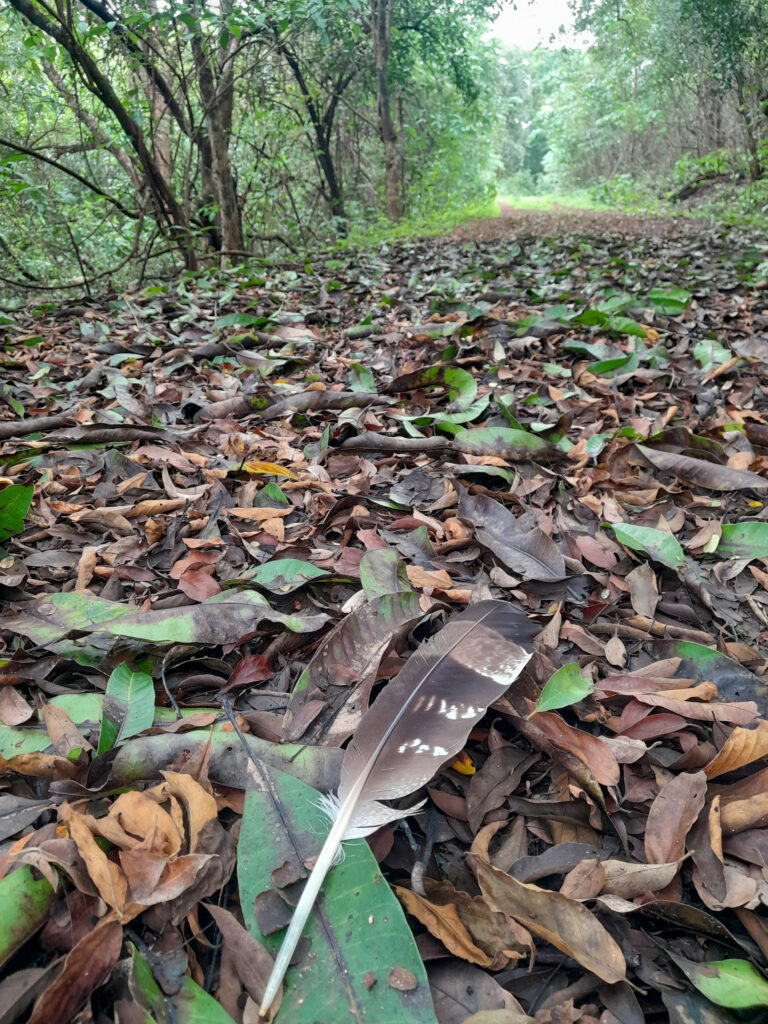
It was a good time spent observing the evergreen jungle in the western fringes of the sanctuary. There were many woody climbers that played the role of pathways and bridges for monkeys and squirrels. On our return back, we stopped for a short break and sat on the muddy trail with little grass growing on it, listening to the singing of birds. This is a great bird watching trail.
As I picked my bag and stepped forward to walk, a slim and slender Bronzeback Tree Snake (non-venomous) with a pointed head crossed the path in front of me. It quickly rushed itself to a medium-sized tree nearby and kept a watch on our every movement. It was thin and easily got camouflaged in the green. We had to observe it very sharply. For a few minutes, the snake lay stunned like a statue transforming itself like a dry stick. Without making sudden movements I went close and took a few photographs and came back. For some time, we watched it from a distance. To move from one branch to another, it raised its forebody in the hanging position and glided away. It kept climbing the branches and reached the top and looked at us. I never felt like taking my eyes away from it, it was that beautiful.


Our day at Phansad WLS ended with delicious home-made food made in the canteen run by the village women. A simple konkan food – pithla bhakri & thecha, dal rice & little sheera. Overall, a day well spent in the wild.
Few things to Note:-
- Tent stay & house stay options are available inside Phansad WLS. Homestay options available in Usroli village near the sanctuary.
- Keep yourself informed about all the do’s & don’ts in the forest.
- There are leeches in abundance near the water bodies, especially during rains. Make yourself aware about these creatures and learn how to handle them without harming them. Check this helpful article from India Hikes- https://indiahikes.com/blog/how-to-handle-leeches-on-a-trek#gref
NANDGAON: THE SLEEPY LITTLE TOWN
As we were riding on the Alibaug Murud road, the tall trees close to the beach provided an opportunity to alternate between the sun and the shade. Nostalgic about our Mumbai-Goa coastal trip memories, we took a halt at Kashid beach. Kashid is a small village close to the Arabian sea. The beach is now a bustling one with lots of activities and has many shacks which cater to the tourists.

Nandgaon is a small town flanked by beautiful houses on both sides of the main road and plantations next to the beach. Most of the residents have converted their bungalows and two-storeyed houses into homestays. The seaside of Nandgaon possesses peacefulness and a walk on its street photographing the quaint houses is a good experience. The street gets a bit busy with vehicles in the evening and as the sun goes to meet the sea, the stray cows occupy most of the streets and with their heads down, quietly move towards the beach to spend the night. The elderly people of the village gather at a roadside shop to spend the evening hours. The people of the village are nice to talk to and happy to share information. So, basically Nandgaon is good for those who are looking to relax and experience slow travel.
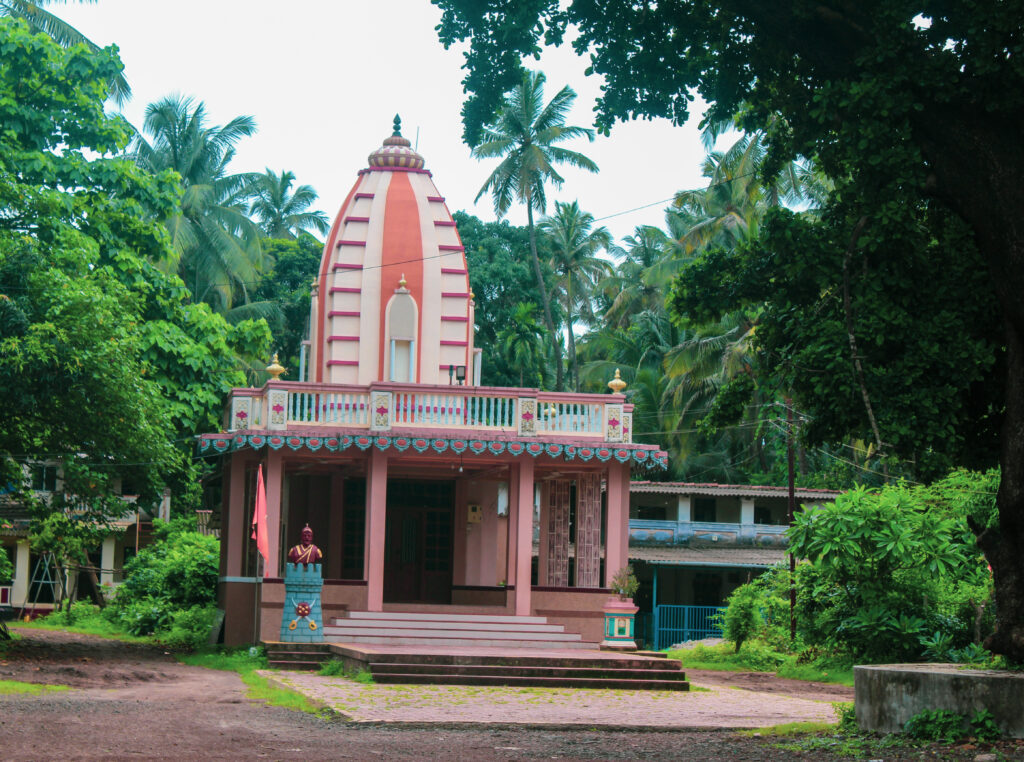



WHAT TO DO IN NANDGAON
- VISIT THE THREE CENTURY OLD SIDDHI VINAYAK TEMPLE
One of the oldest temples of Lord Ganesh in Nandgaon is located near the Nandgaon market. It is clean, colourful and well maintained. According to a belief, a stone resembling a shape of Ganesha idol was found under a tree which was dug up and handed over to a family, after a man named Mr. Joshi had a dream about it. Today many devotees and tourists visit this temple on Maghi Ganesh Utsav (Jan end to early Feb as per Hindu Lunar calendar) and this celebration of Lord Ganesha’s birth is the biggest event in Nandgaon. The temple is easily accessible as it is on the main road going towards Murud.
After visiting the temple, we spent an hour doing street photography and observing the slow paced life of the town. A shop on the road opposite the temple serves hot pakoras and tea. It is here where people stop and have their share of gossiping time with tea. A lady on a bicycle and a lady selling garlands have been having a deep conversation outside the temple gate since we reached. I say it deep because they were still engaged in it when we were about to leave. The state transport buses (ST) stop near the temple, wait for a few seconds and move on. Besides the shop there is another ancient temple of the Hindu deities Vishnu, and his wife Lakshmi, known as Lakshmi Narayana. A woman is spreading a mat inside the mandapa of the temple getting ready for the ‘kirtan’. I photograph the exteriors of the shrine. There was something so pure in the atmosphere of the temple that made me feel calm.

- SOAK IN THE SUNSET VIEWS ON THE SILENT NANDGAON BEACH


Nandgaon beach is protected by hillocks on its two ends. Walking on this 2 km stretch of black sand is a solitary experience. The beach is vacant with no stalls and rides making it a tranquil place for beach lovers to spend some cozy time. From the road, we enter one of the lanes going towards the beach. Towards the south side of the beach, a deserted property has many coconut trees, some tall and straight and some with crooked & swollen trunks. In the evening, the setting sun filtering through the drooping leaves makes for a picturesque photo.
We sat on a rock enjoying the evening breeze and watching the sunset. Life is so different at the beach. Time at the beach is all about how it shifts from mood to the moment. When you are in a mood to just sit and relax, the tides beckons you over to speak to her. And it is difficult to refuse the invitation of the sea. The friendship of the waves and the wind helps you to get back to your inner self.

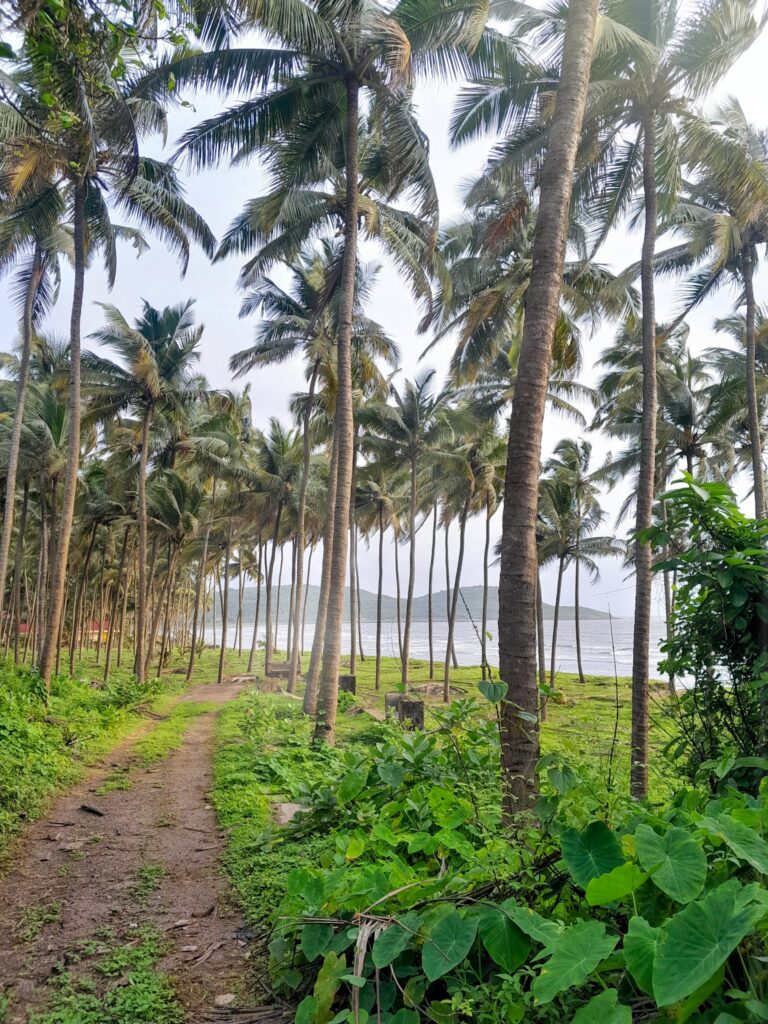
KORLAI FORT- THE GUARDIAN OF THE ARABIAN SEA
A trip to the coastal stretch of Alibaug to Murud without visiting this majestic Portuguese fortification is incomplete. The fort is on top of a hill across the Revdanda creek providing 360 degree view of the enchanting landscape.
The fort can be divided into seven parts from north to south. Tourists usually keep themselves between parts 3 to 7 as the first two comprising the lower portion on the northern side are overgrown with mammoth palm groves and tall grasses. We explored the complete fort. The Arabian sea spreads on its three sides. The high fort walls which are still intact in some parts look magnificent. It became evident to us that centuries ago the fort was built on an island.
From the Korlai village, there are two ways to reach the top. One is from the eastern side with the view of the Kundalika river in sight. The steps take you on the top where the Portuguese church is built. The other is from the western side through the modern lighthouse. It is more convenient to go from the lighthouse as the approach to it passes a network of gray lanes made of concrete reaching for the sea. Vehicles can go till the lighthouse from where steps are to be climbed to reach the entrance door. The fort has a total of four entrance doors. As you climb steps, turn around to see the vast Arabian sea. The wuthering winds will freshen you.
Brief Description of the Layout of the Fort in Seven Parts:
1st part – This consists of the very lower portion towards the northern side of the fort. It has two door entrances on the east and west side. The steps from the east lead down to the strongly built dock nearer to the sea. The part comprises several rooms, a mausoleum, four bastions and three cannons. The place where the canons are kept has a stone carved cross which the Portuguese called as Santa Cruz (Krusachi Bateri).


2nd part – This portion now consists of tall palm groves and dense vegetation. It has one bastion and look out points on the walls to keep a watch.

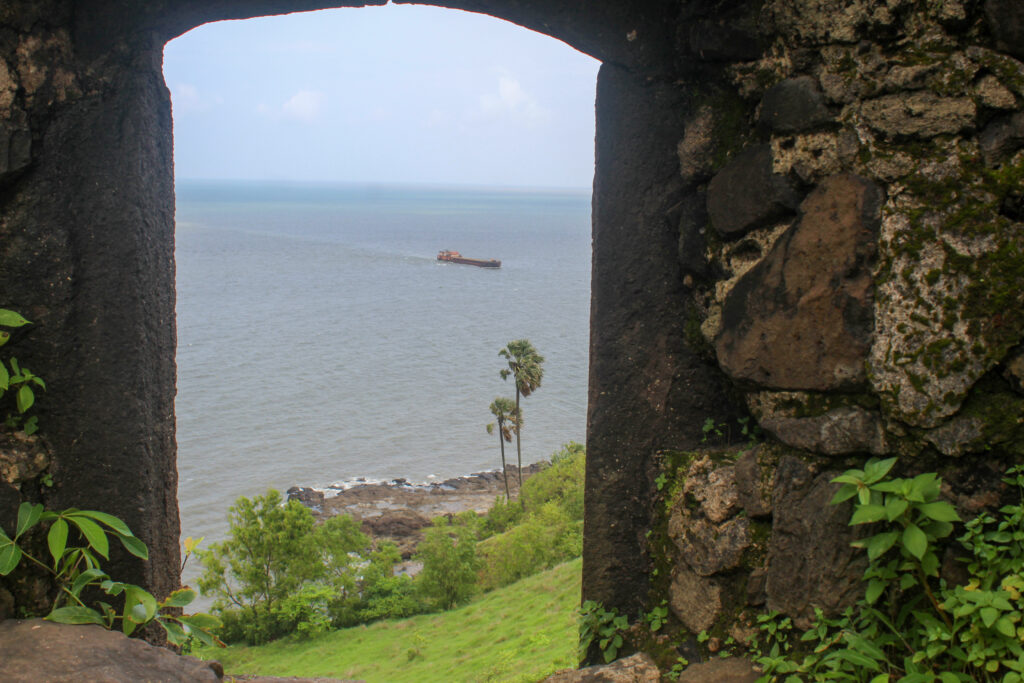
3rd & 4th part – This part has one door entrance which we entered through the side of the lighthouse. Towards the right from the door, there is one cannon, two bastions and a rock-cut cistern (water tank). The bastion towards the east gives a view of the Revdanda Creek and Kundalika river estuary meeting the sea.

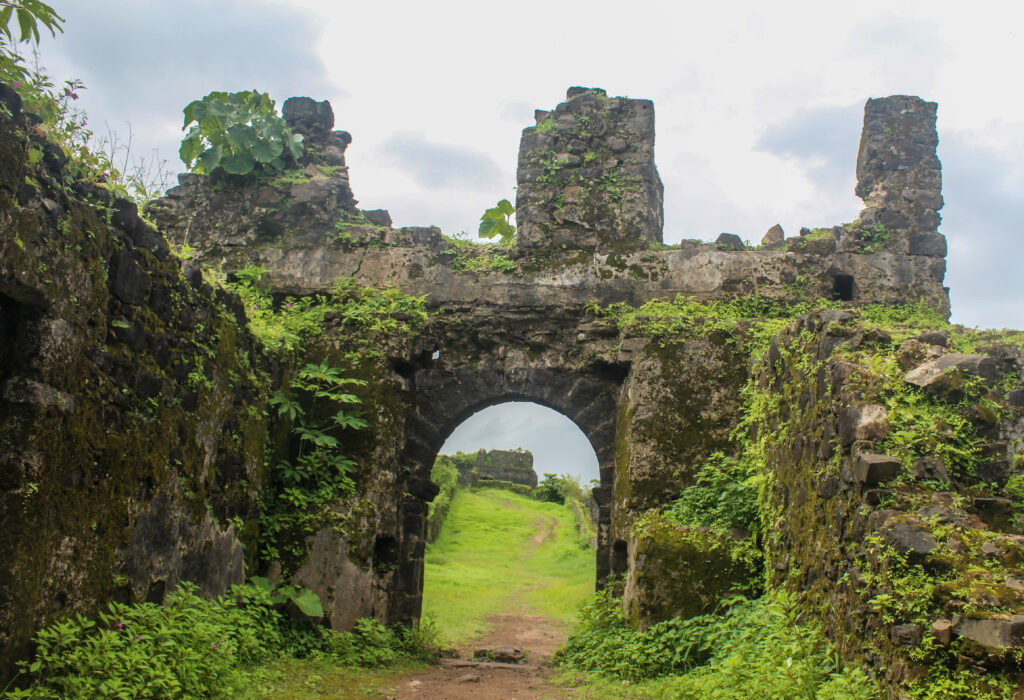

5th part – This portion has a shiv mandir, tulsi vrindavan and three water tanks. The ramparts of the wall are very much intact and can be walked upon.

6th part – This has a door entrance and the steps going down to Korlai village, a church and a few Portuguese inscriptions.





7th part – It has three cannons, two bastions and a bunker (khandak). A bunker is an underground shelter built with strong walls to protect it against gunfire and bombs. It gives a beautiful view of the Korlai village settled between the Arabian sea and Kundalika river.


So, this proves that the fort still stands in full majesty because the remains have been well preserved. The panoramic views from the top are simply breathtaking. The fort is of utmost historical significance and is well maintained.
OTHER ATTRACTIONS WE VISITED NEAR MURUD
DATTA MANDIR – The temple is located atop a hill and is the highest point of Murud which offers the best views of the sunset. It is approached by steps or by a motorable road. The shrine offers panoramic views of Murud town hiding beneath a green canopy of coconut trees.

KHOKRI TOMBS – Khokri is a small village around 6 km from Murud. On the road going towards Agardanda Jetty, the 3 big tombs catch attention. These were built by the Siddi dynasty of Janjira in the 18th century.

NAWAB PALACE – Spread over an area of 45 acres, the grand palace of Siddhi Shah Mehmood Khan depicts Mughal architectural style. One has to be content seeing it from out as entry is restricted. Currently, it is known as Ahmedganj Rajwada.

FINAL WORDS
The road trip which started with excitement, ended with joyful memories. Each day we had a different taste of travel. Within it’s boundaries, Murud has a potpourri of travel offering. The wilderness of the forest in Phansad, vastness of the coast, historical monuments and palaces, ancient temples and mosques, beautiful scenic villages and from busy markets to deserted lanes, it has almost everything for a traveller who is in love with the roads.
And while roaming with roads, we have experienced Murud as leisurely as possible. Because, we believe it is important not to rush in ticking for destinations but living the journey as it comes.
A 3 day road trip may not be enough if a place has so much to offer. But no matter, how many days you have, try to slow down and you will enjoy travel like never before.




